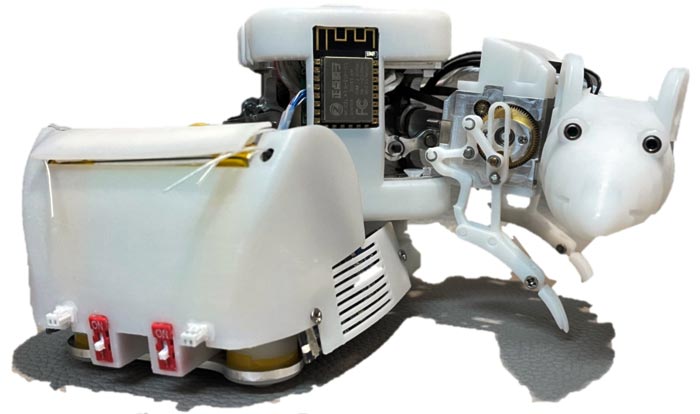A step towards natural interaction between robots and animals

This biomimetic robotic rat equipped with a miniature vision perception system has 9 active degrees of freedom. Based on its agile rat-like motion, the robot can interact autonomously with actual rats.
Credit: Cyborg and Bionic Systems
Laboratory rats have been shown to have genetic consistency and similar responses to drugs with humans, and thus become ideal animal models for research and testing of new drugs. However, due to individual difference, it is still a challenging task to find a method of unified behavior control and evaluation.
Actually, bioinspired robots can take advantage of their programmability and reconfigurability to replace rats, so as to effectively solve these problems. It has been verified that robots can influence or even control the behavior of actual rats to a certain extent during robot-rat interaction. Some researchers have done a lot of work related to the autonomous interaction. However, those studies still lack behavior detection, fast object tracking and automatic interaction framework.
Recently, a team of scientists from Beijing Institute of Technology, China proposed an automatic robot-rat interaction framework that enables a robotic rat to realize real-time localization, tracking and movement analysis of a laboratory rat (Rattus norvegicus) on IROS 2021. The preliminary robot-rat interaction tests show that the robot is able to track a fast-moving rat for a duration of 10 minutes steadily.
To the best of their knowledge, it is the first time that a rat-sized robot achieves a continuous tracking of actual rats by a built-in miniature stereo vision system. Experimental results show that the sequence of state vectors can characterize some typical behaviors of the actual rat.
What’s more, the team also designed a quadruped robotic rat by mimicking the morphological and kinetic characteristics of rats. Compared with other quadruped robotic rat, the newly developed robotic rat features smaller turning radius, higher walking velocity and strong capability.
Moreover, the new quadruped robotic rat shows high adaptability in crossing irregular passages, climbing slopes, surmounting obstacles and recovering from falls. These capabilities enable it to resolve difficulties of passing through narrow spaces and performing tasks simultaneously. Apart from operating in narrow spaces, the robotic rat could also benefit behaviour reasearhes by promoting the autonomy and reproducibility of rat-robot intereaction experiments.
Journal: Cyborg and Bionic Systems
Method of Research: News article
Subject of Research: Not applicable
Media Contact
Ning Xu
Beijing Institute of Technology Press Co., Ltd
xuning1907@foxmail.com
All latest news from the category: Information Technology
Here you can find a summary of innovations in the fields of information and data processing and up-to-date developments on IT equipment and hardware.
This area covers topics such as IT services, IT architectures, IT management and telecommunications.
Newest articles

Innovative 3D printed scaffolds offer new hope for bone healing
Researchers at the Institute for Bioengineering of Catalonia have developed novel 3D printed PLA-CaP scaffolds that promote blood vessel formation, ensuring better healing and regeneration of bone tissue. Bone is…

The surprising role of gut infection in Alzheimer’s disease
ASU- and Banner Alzheimer’s Institute-led study implicates link between a common virus and the disease, which travels from the gut to the brain and may be a target for antiviral…

Molecular gardening: New enzymes discovered for protein modification pruning
How deubiquitinases USP53 and USP54 cleave long polyubiquitin chains and how the former is linked to liver disease in children. Deubiquitinases (DUBs) are enzymes used by cells to trim protein…



